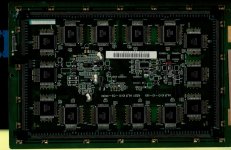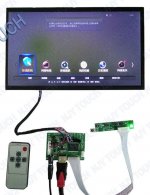Trash80toHP_Mini
NIGHT STALKER
I've outlined a direction I'd like to go with my extra Luggable: Macintosh Portable: LuggablePi
It involves installing (it's looking like it will fit) an 11.6" 1080p LCD in a customized 3D printed bezel. There'd to be some flavor of Pi baking in the HDD's cubic for playtime in that world and I'm trying to figure out how to use that Pi filling to adapt the Portable's video output and throw it up on that big, beautiful LCD so that it looks juuust right for 68000 playtime.
I was thinking in terms of tapping the LCD cable connector on the mobo, feeding it to the Pi for translation into something it can display on the 1080p LCD. That was after considering use of the Portable's video out setup, but IIRC it was never really used or documented? Remembering the bit-banging approach to some of this kinda crap, I hit the docs:
The video port seems a no-go?
Converting the signals meant for the stock LCD . . . I have no idea, but that'd be my fully reversible preference!
Might banging the snot outta that SRAM IC be the easiest in terms of signal/data conversion? Soldering crap to the mobo of even my "Hackable Lugggable" goes against the grain for me these days.
What do you GPIO cowboys think of wedging the video feed at the LCD cable socket? Non-trivial or impossible?
It involves installing (it's looking like it will fit) an 11.6" 1080p LCD in a customized 3D printed bezel. There'd to be some flavor of Pi baking in the HDD's cubic for playtime in that world and I'm trying to figure out how to use that Pi filling to adapt the Portable's video output and throw it up on that big, beautiful LCD so that it looks juuust right for 68000 playtime.
I was thinking in terms of tapping the LCD cable connector on the mobo, feeding it to the Pi for translation into something it can display on the 1080p LCD. That was after considering use of the Portable's video out setup, but IIRC it was never really used or documented? Remembering the bit-banging approach to some of this kinda crap, I hit the docs:
DDC (Display Driver Chip)
The DDC provides the Macintosh PowerBook 100 computer’s interface to the LCD (liquid crystal display). Its primary function is to keep the computer’s main processor from having to refresh the screen (LCD display), thereby allowing the processor to do more useful work. The DDC generates horizontal and vertical synchronization pulses and all other signals necessary to make the flat-panel display work. It also supports its own video 32K x 8-bit SRAM (static RAM). In addition, the DDC limits the CPU from refreshing the display and thereby allows the CPU to do more useful work.
The video port seems a no-go?
Converting the signals meant for the stock LCD . . . I have no idea, but that'd be my fully reversible preference!
Might banging the snot outta that SRAM IC be the easiest in terms of signal/data conversion? Soldering crap to the mobo of even my "Hackable Lugggable" goes against the grain for me these days.
What do you GPIO cowboys think of wedging the video feed at the LCD cable socket? Non-trivial or impossible?
Last edited by a moderator:


